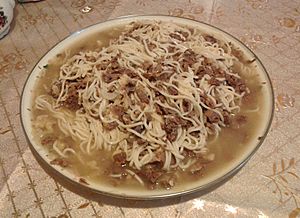Beshbarmak facts for kids
| Type | Noodle |
|---|---|
| Place of origin | Turkic countries |
| Region or state | Central Asia |
| Main ingredients | Flour, water, meat, onion |
Beshbarmak is a very popular dish from Central Asian cuisine. Its name comes from the Kazakh and Kyrgyz words meaning "five fingers." This is because people traditionally eat this dish with their hands! You might also hear it called naryn in places like Uzbekistan and Kazakhstan. In other areas, it's known as turama or dograma.
Beshbarmak is a main national dish in Kyrgyzstan and Kazakhstan. It's usually made with finely chopped boiled meat, mixed with dough (like flat noodles) and a special onion sauce called chyk. Before eating Beshbarmak, people often have shorpo, which is a tasty meat broth served in bowls. After the main dish, another broth called ak-serke is sometimes served, which is thought to help with digestion. For special celebrations, Beshbarmak can include special sausages like kazy and chuchuk.
History of Beshbarmak
The food in Central Asia developed because people lived a nomadic life. This means they moved around a lot with their animals. Because of this, their dishes often have a lot of meat and dairy products.
Beshbarmak became known as a national dish during the time of the Soviet Union. Two important books about food helped make it famous as a traditional meal for the people of Central Asia.
Serving Beshbarmak
Serving Beshbarmak is a special tradition. If an animal, like a sheep, is prepared for guests, the host gives different pieces of meat, called ustukan, to different people. This depends on their age, gender, and importance in the group.

To show respect, the oldest people and honored guests always get the best cuts of meat. On special occasions, the guest of honor or the oldest male might receive the bash, which is the head of the animal. They then cut pieces from it to share with others. The oldest men often receive the jambash, which is the thigh bone. The most respected women get the kuiruk or kuymulchak, which is the tailbone.
Younger adults usually receive the legs and shoulders. The smaller bones are saved for the daughter-in-law of the house. Children are often given the omurtka, which is the spine. Other special meat cuts include parts like the shin bone, thigh bone, ribs, and shoulder blade.
How to Prepare Beshbarmak
To make classic Beshbarmak, especially in northern Kyrgyzstan, you need a good, sharp knife called maki. This knife is used to thinly chop all the ingredients before they are placed on the dastarkhan (a traditional low table or cloth for meals). You also need a large pot to boil the meat and noodles, and a rolling pin to roll out the dough for the noodles.
Beshbarmak is made by first boiling a piece of meat. This can be horse meat, lamb, or horsemeat sausages like kazy or chuchuk. In warmer weather, people usually make Beshbarmak with mutton.
The noodle dough is made from flour, water, eggs, and salt. After mixing, the dough rests for about 40 minutes. Then, it is rolled out very thinly and cut into wide noodles. These noodles are then cooked in the meat broth.
See also
 In Spanish: Beshbarmak para niños
In Spanish: Beshbarmak para niños



